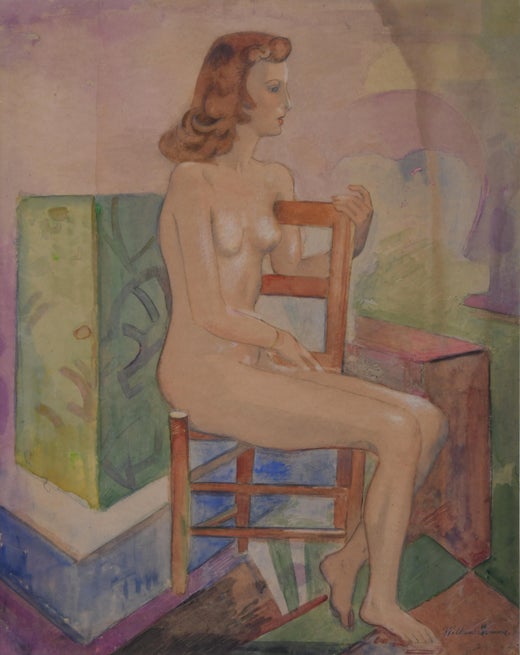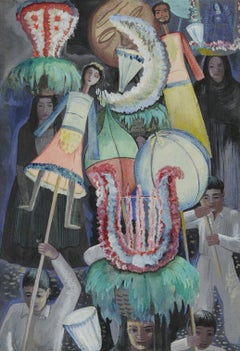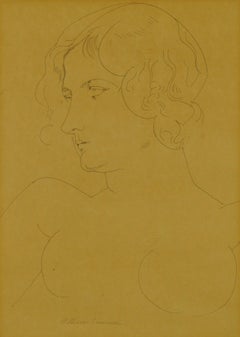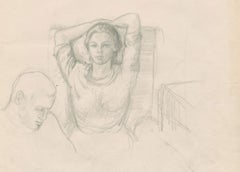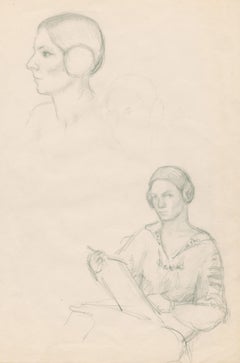Want more images or videos?
Request additional images or videos from the seller
1 of 9
William SommerFlapper in a Black Hatc. 1925
c. 1925
Price:$2,000
$2,500List Price
About the Item
- Creator:William Sommer (1867-1949, American)
- Creation Year:c. 1925
- Dimensions:Height: 10.75 in (27.31 cm)Width: 15.5 in (39.37 cm)
- Medium:
- Movement & Style:
- Period:
- Condition:Original Condition.
- Gallery Location:Fairlawn, OH
- Reference Number:Seller: FA70231stDibs: LU14014082972
William Sommer
William Sommer is seen as a key person in bringing European modernism to Northeast Ohio. He was born in Detroit, Michigan, and in his youth apprenticed for seven years to a lithographer. He briefly studied at an art academy in Germany and then worked as a lithographer in New York before moving to Cleveland, where he was awarded a major contract with the Otis Lithography Company. There he became friends with sculptor and painter William Zorach, and the two, determined to be fine artists, began painting together on weekends. They also became intrigued by avant-garde movements, especially after Zorach's trip to Paris in 1910. In 1911, Sommer co-founded a group in Cleveland called the Kokoon Club, a mixed group of commercial artists and radical modernists who sought the freedom to pursue their independent tendencies. They converted a tailor's shop into a studio and held exhibitions and lectures and organized an annual masked ball that became the focus of Cleveland's bohemian life. In 1913, he and his colleagues began painting at Brandywine, about 30 miles south of Cleveland and made a school house into a studio. They devoted increasing time to watercolor painting because they could work spontaneously and it would dry quickly. Rejecting the conventional ideas of beauty, they strove for the expression of emotion and spontaneity and fantasy. One of Sommer's most successful students was Charles Burchfield. As he was perfecting his mature style, he had financial difficulties because he made his living from commercial lithography, which was becoming obsolete, and the Depression was hitting the nation causing him to lose his job. He became a WPA artist, doing murals in northeastern Ohio. After his death at age 82, he was largely forgotten until 1980 when Hilton Kramer, a "New York Times" critic, praised his work. In May to July, 1994, the Ohio Arts Council held a retrospective of his work at the Riffe Gallery in Columbus. His work is found in many public collections including the National Museum of American Art, The Metropolitan Museum of Art, and the Whitney Museum of American Art.
About the Seller
5.0
Recognized Seller
These prestigious sellers are industry leaders and represent the highest echelon for item quality and design.
Platinum Seller
Premium sellers with a 4.7+ rating and 24-hour response times
Established in 1978
1stDibs seller since 2013
814 sales on 1stDibs
Associations
International Fine Print Dealers Association
Authenticity Guarantee
In the unlikely event there’s an issue with an item’s authenticity, contact us within 1 year for a full refund. DetailsMoney-Back Guarantee
If your item is not as described, is damaged in transit, or does not arrive, contact us within 7 days for a full refund. Details24-Hour Cancellation
You have a 24-hour grace period in which to reconsider your purchase, with no questions asked.Vetted Professional Sellers
Our world-class sellers must adhere to strict standards for service and quality, maintaining the integrity of our listings.Price-Match Guarantee
If you find that a seller listed the same item for a lower price elsewhere, we’ll match it.Trusted Global Delivery
Our best-in-class carrier network provides specialized shipping options worldwide, including custom delivery.You May Also Like
Untitled (Woman's Head in Profile)
By Joseph Stella
Located in Bryn Mawr, PA
Untitled (Woman's Head in Profile)
Watercolor and pastel on paper laid down on board, 20 x 13 inches (50.8 x 33 cm)
Framed dimensions: 27 x 20 inches
Signed upper left: Joseph Stella...
Category
20th Century American Modern Portrait Drawings and Watercolors
Materials
Paper, Pastel, Watercolor, Board
"Spiritual Self-Portrait" Watercolor, Ink, Portrait, Nude, Linear Grid, Colors
By Artis Lane
Located in Detroit, MI
"Spiritual Self-Portrait" is a portrait of the artist by the artist. She has presented herself nude gazing boldly and directly at the viewer not so much challenging, but inviting dia...
Category
Late 20th Century American Modern Portrait Drawings and Watercolors
Materials
Paper, Ink, Watercolor
Price Upon Request
H 33 in W 26.5 in
Alfred Bendiner, La Alsacienne (pair)
By Alfred Bendiner
Located in New York, NY
Leave it to the Bendiners to find an Alsatian restaurant in Paris (La Taverne Alsacienne) and use it's stationary to such a great end! And thank goodness that the paper required two ...
Category
1960s American Modern Figurative Drawings and Watercolors
Materials
Watercolor
Alfred Bendiner, (Baseball Hitter and Pitcher -- The Philadelphia Phillies?)
By Alfred Bendiner
Located in New York, NY
Of course it's possible that these baseball players aren't from a Philadelphia team, but I doubt it. There was so much drama and intrigue with both the Philadelphia Phillies...
Category
Mid-20th Century American Modern Figurative Drawings and Watercolors
Materials
India Ink, Watercolor
Alfred Bendiner, Baccaloni in Rosenkavalier
By Alfred Bendiner
Located in New York, NY
The Italian opera singer, Salvatore Baccaloni (1900-1969) often took comic roles. He worked with several opera companies in Philadelphia between 1951 and 1966. Bendiner was a world t...
Category
Mid-20th Century American Modern Figurative Drawings and Watercolors
Materials
Gouache
1950s "Purple Head" Mid Century Oil and Pastel Portrait Original Drawing
By Donald Stacy
Located in Arp, TX
Donald Stacy
"Purple Head"
c.1950s
Gouache and oil pastel on paper
13.75" x 17" unframed
Unsigned
Came from artist's estate
Donald Stacy (1925-2008) New Jersey
Studied: Newark School of Fine Art
The Art Students League
Pratt Graphic Arts Center
University of Paris 1953-54
University of Aix-en-Provence 1954-55
Faculty: Art Department of the New School
Museum of Modern Art
School of Visual Arts
Stacy Studio Workshop
Exhibitions: Grand Central Moderns
George Wittenborn
The New School
Print Exhibitions, Chicago
University of Oklahoma
Honolulu Museum
Monclair Museum
Wisconsin State College
Louisiana Art Commission
Philadelphia Print...
Category
Mid-20th Century American Modern Portrait Paintings
Materials
Paper, Oil Pastel, Gouache
$570 Sale Price
40% Off
H 17 in W 13.75 in
The Scapegoat II, Court Drawing by Marshall Goodman
By Marshall Goodman
Located in Long Island City, NY
The Scapegoat II
Marshall Goodman, American (1916–2003)
Watercolor on paper
Size: 10 x 10 in. (25.4 x 25.4 cm)
For the last ten years of his life Mr. Goodman worked as a Courtroom Illustrator. for high profile trials such as John Gotti...
Category
1990s American Modern Portrait Drawings and Watercolors
Materials
Watercolor
Meryl Streep & Cher, Caricature Watercolor Painting by Marshall Goodman
By Marshall Goodman
Located in Long Island City, NY
Artist: Marshall Goodman, American XXth
Title: Meryl Streep and Cher
Year: circa 1980
Medium: Watercolor on Paper, Signed
Image Size: 20 x 25.5 inches
Category
1980s American Modern Portrait Drawings and Watercolors
Materials
Watercolor
$2,500
H 20 in W 25.5 in D 0.1 in
Chaim Gross Mid Century Mod Judaica Jewish Watercolor Painting Rabbis WPA Artist
By Chaim Gross
Located in Surfside, FL
Chaim Gross (American, 1904-1991)
Watercolor painting
Rabbinical Talmudic Discussion
Hand signed
17 x 29 framed, paper 10 x 22
Chaim Gross (March 17, 1904 – May 5, 1991) was an ...
Category
Mid-20th Century American Modern Figurative Drawings and Watercolors
Materials
Paper, Watercolor
$1,200
H 17 in W 29 in D 7 in
Chaim Gross Judaica Jewish Watercolor Painting Rabbi Klezmer Music WPA Artist
By Chaim Gross
Located in Surfside, FL
Chaim Gross (American, 1904-1991)
Watercolor with pencil painting
Rabbi Klezmer music concert, flute player.
Hand signed
framed: 15 X 28.5, paper: 9.5 X 23
Chaim Gross (March 17...
Category
Mid-20th Century American Modern Figurative Drawings and Watercolors
Materials
Paper, Watercolor
More From This Seller
View AllHeaddress Procession
By Honore Guilbeau
Located in Fairlawn, OH
Headdress Procession
Watercolor, c. 1950's
Signed by the artist in ink, lower right
The Headdress Procession occurs every year as part of the Christmas celebrations in Oaxaca.
Guilbe...
Category
1950s American Modern Portrait Drawings and Watercolors
Materials
Watercolor
Female Nude in Profile
By William Sommer
Located in Fairlawn, OH
Woman
Pen and ink on paper, c. 1925-1928
Signed in pencil lower left
Exhibited: Akron Art Institute (Akron Art Museum),
William Sommer Retrospective, Oct. 25 to Nov. 29,
1 970
Illu...
Category
1920s American Modern Drawings and Watercolor Paintings
Materials
Ink
Self Portrait with Arms Over Head, vignette on Paul Cadmus on left
Located in Fairlawn, OH
Self Portrait with Arms Over Head, vignette on Paul Cadmus on left
Graphite drawing on thin wove paper, c. 1940's
Unsigned
Provenance: Paull Cadmus
Jon F. Anderson (1937-2018)
Condition:
Sheet size: 15 x 10 1/4 inches
Born in Hoboken, New Jersey, Margaret Hoening (1906–1998) was a painter and an etcher perhaps best known for her
photographs as part of the PaJaMa photography collective. After attending Smith College, she settled in New York, where
she pursued formal artistic training at the Art Students League. There, she met the artist couple Paul Cadmus and Jared
French. In 1937, she married French, fifteen years her junior, who had spent the previous decade with Cadmus. The trio
formed a tight bond, with Cadmus and French continuing their relationship.
Born in Hoboken, New Jersey, Margaret Hoening (1906–1998) was a painter and an etcher perhaps best known for her
photographs as part of the PaJaMa photography collective. After attending Smith College, she settled in New York, where
she pursued formal artistic training at the Art Students League. There, she met the artist couple Paul Cadmus and Jared
French. In 1937, she married French, fifteen years her junior, who had spent the previous decade with Cadmus. The trio
formed a tight bond, with Cadmus and French continuing their relationship. Together, the three formed PaJaMa (a mashup of their first names, Paul, Jared, and Margaret). Using Hoening’s Leica, they captured themselves, their artist friends,
and members of the gay community posing in artful tableaux on the beaches of Fire Island, Provincetown, and Nantucket
over the following eight years. Those captured by their camera include the photographer George Platt Lynes; Cadmus’s
sister and artist Fidelma; artist Bernard Perlin; and Monroe Wheeler, director of exhibitions at the Museum of Modern Art,
among others. Though she produced few canvases, Hoening’s paintings demonstrate the influences of French and Cadmus,
particularly with her adoption of the time-intensive, traditional medium of egg tempera that they championed.
In the 1940s, the Frenches’ social circle continued to expand. They befriended the British author E.M. Forster, who stayed
with them on his first trip to New York in 1947, spending a few days with them in Provincetown, and visiting them again
in 1949. When Cadmus began a relationship with the young artist George Tooker in 1944, the trio became a foursome,
with Tooker regularly vacationing with the group and appearing in PaJaMa’s photographs...
Category
1940s American Modern Portrait Drawings and Watercolors
Materials
Graphite
Self Portrait sketching with Vignette in Profile
Located in Fairlawn, OH
Self Portrait sketching with Vignette in Profile
Graphite on thin wove paper, c. 1940's
Unsigned
Condition: Small nicks in the right margin, not affecting the image
Sheet size: 14 1/2 x 10 inches
Provenance: Paul Cadmus
Jon F. Anderson (1937-2018)
Born in Hoboken, New Jersey, Margaret Hoening (1906–1998) was a painter and an etcher perhaps best known for her
photographs as part of the PaJaMa photography collective. After attending Smith College, she settled in New York, where
she pursued formal artistic training at the Art Students League. There, she met the artist couple Paul Cadmus and Jared
French. In 1937, she married French, fifteen years her junior, who had spent the previous decade with Cadmus. The trio
formed a tight bond, with Cadmus and French continuing their relationship.
Born in Hoboken, New Jersey, Margaret Hoening (1906–1998) was a painter and an etcher perhaps best known for her
photographs as part of the PaJaMa photography collective. After attending Smith College, she settled in New York, where
she pursued formal artistic training at the Art Students League. There, she met the artist couple Paul Cadmus and Jared
French. In 1937, she married French, fifteen years her junior, who had spent the previous decade with Cadmus. The trio
formed a tight bond, with Cadmus and French continuing their relationship. Together, the three formed PaJaMa (a mashup of their first names, Paul, Jared, and Margaret). Using Hoening’s Leica, they captured themselves, their artist friends,
and members of the gay community posing in artful tableaux on the beaches of Fire Island, Provincetown, and Nantucket
over the following eight years. Those captured by their camera include the photographer George Platt Lynes; Cadmus’s
sister and artist Fidelma; artist Bernard Perlin; and Monroe Wheeler, director of exhibitions at the Museum of Modern Art,
among others. Though she produced few canvases, Hoening’s paintings demonstrate the influences of French and Cadmus,
particularly with her adoption of the time-intensive, traditional medium of egg tempera that they championed.
In the 1940s, the Frenches’ social circle continued to expand. They befriended the British author E.M. Forster, who stayed
with them on his first trip to New York in 1947, spending a few days with them in Provincetown, and visiting them again
in 1949. When Cadmus began a relationship with the young artist George Tooker in 1944, the trio became a foursome,
with Tooker regularly vacationing with the group and appearing in PaJaMa’s photographs...
Category
1940s American Modern Portrait Drawings and Watercolors
Materials
Graphite
Study for "The Jade Necklace"
By Joseph Stella
Located in Fairlawn, OH
Study for the painting "The Jade Necklace"
Silver point drawing on prepared paper, n.d.
Stamp lower right: "J Stella/JML Coll" (see photo)
The painting of the same sitter and title, measures 21 3/4 x 18 1/8 inches, formerly handled by Richard York Gallery. (see photo)
Provenance:
Collection of the artist
Mrs. Giovanni Stella, the artist's sister-in-law
Josephine M...
Category
20th Century American Modern Portrait Drawings and Watercolors
Materials
Pencil
Stolen Moments #3
By Darius Steward
Located in Fairlawn, OH
Signed with the artist's initials lower right
From the Series: Stolen Moments
Signed with the artist's "Yummy" blindstamp lower right
Note:
Darius Steward is establishing himself...
Category
2010s Contemporary Portrait Drawings and Watercolors
Materials
Watercolor
